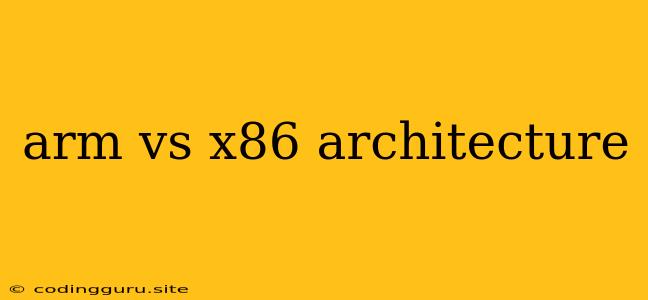The Battle of the Architectures: ARM vs. x86
The world of computing is built upon a foundation of architectures, invisible frameworks that dictate how our devices process information. Two giants dominate this landscape: ARM and x86. While both are used in countless devices, they cater to different needs, offering distinct advantages and disadvantages. So, what sets these architectures apart, and which one reigns supreme?
What is ARM?
ARM, short for Advanced RISC Machine, is a reduced instruction set computing (RISC) architecture. It's known for its efficiency and low power consumption. Instead of complex instructions, ARM uses simpler, faster ones, which translates to greater battery life and less heat generation. This makes ARM the preferred choice for mobile devices, embedded systems, and even some servers.
What is x86?
x86, on the other hand, is a complex instruction set computing (CISC) architecture. Developed by Intel, it's characterized by its versatility and power. Its intricate instructions allow for sophisticated processing, making it ideal for desktops, laptops, and high-performance computing tasks.
ARM vs. x86: A Head-to-Head Comparison
Let's break down the key differences between ARM and x86:
1. Power Consumption:
- ARM: Low power consumption due to its efficient design.
- x86: Higher power consumption, especially with high-performance processors.
2. Performance:
- ARM: Typically known for its efficiency and low power consumption, but can achieve high performance in specific scenarios.
- x86: Offers higher peak performance for demanding tasks, including gaming and video editing.
3. Cost:
- ARM: Generally more cost-effective for mobile devices and embedded systems.
- x86: Typically more expensive for high-performance processors.
4. Availability:
- ARM: Found in mobile devices, embedded systems, servers, and even some laptops.
- x86: Primarily used in desktops, laptops, servers, and high-performance computing.
5. Operating System Support:
- ARM: Supports both Linux and Android, with increasing support for other operating systems.
- x86: Traditionally used with Windows and Linux, but can also run macOS.
Advantages of ARM
- Low power consumption: ARM's efficiency translates to longer battery life in mobile devices.
- Cost-effectiveness: ARM processors are generally cheaper, making them ideal for budget devices.
- Scalability: ARM architecture can be scaled to meet the needs of various devices, from small embedded systems to powerful servers.
Advantages of x86
- High performance: x86 offers superior processing power for demanding tasks.
- Wide operating system support: x86 is compatible with a broad range of operating systems.
- Established ecosystem: x86 enjoys a mature ecosystem of software and hardware.
Choosing the Right Architecture: When to Use ARM or x86
The choice between ARM and x86 depends largely on your specific needs:
- For mobile devices and embedded systems: ARM is the go-to choice due to its power efficiency, cost-effectiveness, and wide availability in this market.
- For high-performance computing, gaming, and video editing: x86 offers the power needed for demanding tasks.
- For servers: ARM is gaining traction in the server market due to its power efficiency and cost savings, but x86 remains the dominant force.
- For laptops: ARM-based laptops are emerging as a viable alternative to traditional x86 laptops, offering long battery life and compact designs.
The Future of ARM and x86
The line between ARM and x86 is becoming increasingly blurred. ARM is expanding into new markets, including laptops and servers, while x86 continues to evolve with advancements in performance and efficiency. It's likely that both architectures will continue to coexist and innovate, pushing the boundaries of computing in the years to come.
Conclusion
ARM and x86 are two powerful architectures that shape the world of computing. They each have strengths and weaknesses, making them ideal for different applications. Ultimately, the choice between ARM and x86 comes down to your specific needs and priorities. Both offer compelling options for different scenarios, ensuring a vibrant and diverse future for the world of technology.
